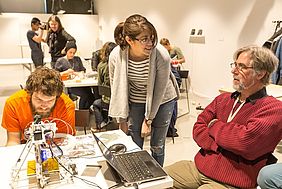On October 15th we launch the first open Maker Event for the new Makerspace for Professionals Network with DF Stockholm (Swedish Computer Society, Dataföreningen).
You are welcome to join us, learn more about why this is valuable for any profession and also for becoming a more skilled digital citizen.
October 15th, 18.00-20:30
We start with networking "fika" at 17.30
Agenda
17.30 Coffee, tea and sandwich at EIT Digital Co-location Centre, Electrum, elevator C, floor 3, Isafjordsgatan 26, Kista
18.00 Welcome and brief intro, Marianne Loor, Communications, EIT Digital Stockholm Node
18.10 There are only two rules in a Makerspace, Mark Smith, Prof.IT Products, School of ICT, KTH
18.20 Walk over to the "lab" where there will be Arduino boards to start making great creations.
If you would like to take part in the "Kista in Lights" happening in late November, we are happy for any interactive use relating to lights in the dark winter nights….
We are assisted by a team of Master students who are mainly English speaking.
A Maker Space is a community to share ideas how you solve a problem or a need. In a the Maker Space you co-create using simple software and 3D printers. Arduino is a key tool to learn new things. Anyone - children, hobbyists, artists, programmers - can start tinkering just following the step by step instructions of a kit, or sharing ideas online with other members of the Arduino community.
We use Arduino
Arduino is an open-source prototyping platform based on easy-to-use hardware and software. Arduino boards are able to read inputs - light on a sensor, a finger on a button, or a Twitter message - and turn it into an output - activating a motor, turning on an LED, publishing something online. You can tell your board what to do by sending a set of instructions to the microcontroller on the board. To do so you use the Arduino programming language and the Arduino Software (IDE), based on Processing.
Thanks to its simple and accessible user experience, Arduino has been used in thousands of different projects and applications. The Arduino software is easy-to-use for beginners, yet flexible enough for advanced users. It runs on Mac, Windows, and Linux. Teachers and students use it to build low cost scientific instruments, to prove chemistry and physics principles, or to get started with programming and robotics. Designers and architects build interactive prototypes, musicians and artists use it for installations and to experiment with new musical instruments.

